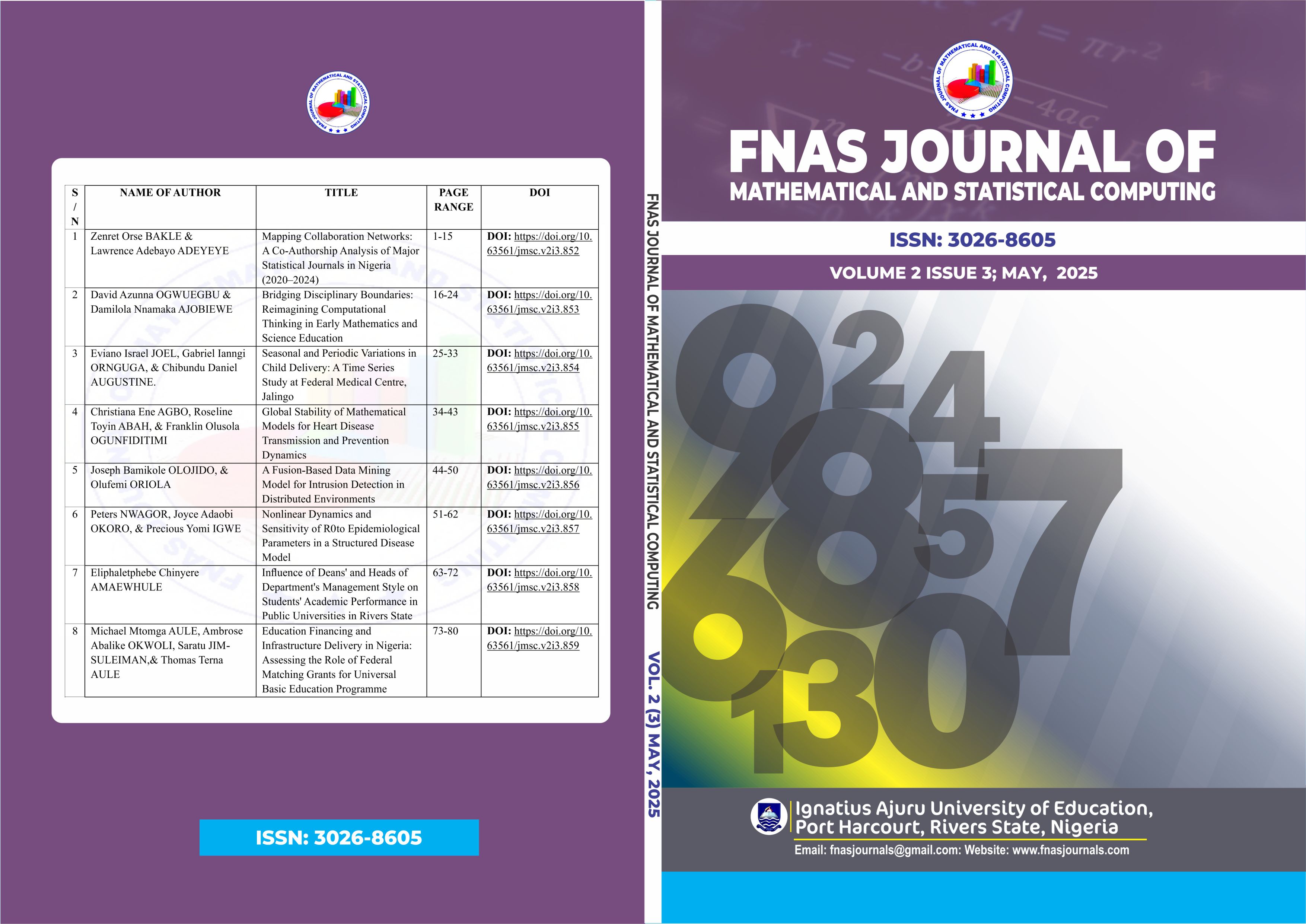Bridging Disciplinary Boundaries: Reimagining Computational Thinking in Early Mathematics and Science Education
Main Article Content
Abstract
In this paper, it is maintained that introducing computational thinking (CT) in early mathematics and science education is an integrative approach showing the interconnectedness of real problems, rather than their compartmentalization. CT is a methodical, transferable problem-solving process with five critical pillars: decomposition, recognition of patterns, abstraction, algorithmic thinking, and evaluation. CT provides a strong cognitive foundation that makes learners more resilient, creative, and rational in their thinking if it is introduced at the early stages of learning. A conceptual framework is offered to inform the implementation of CT in early childhood education classrooms and addresses five interconnected dimensions: contextual learning, inquiry-based investigation, interdisciplinary integration, teacher and curriculum support, and developmental appropriateness. These pillars facilitate the design of learning settings that encourage active engagement with content in the form of age-based, hands-on activities. Unplugged activities, project-based learning, guided digital tool use, and storytelling through logic sequences enhance hands-on methods that are meant to encourage collaboration, critical thinking, and exploration. Theoretical Integrative Research Approach was used to develop the framework. In spite of the potential obstacles, including rigid curricula, teacher lack of preparation, and equity issues, the long-term gains far exceed these barriers. Teaching CT in the early years provides students with the 21st-century skills they require and cultivates a mindset of lifelong learning. This strategy has the potential to transform early childhood science, technology, engineering, and mathematics (STEM) education and enhance education results through the long-term commitment of policymakers, curricula developers, and educators.
Article Details
References
Basu, S., Biswas, G., & Kinnebrew, J. (2016). Using Multiple Representations to Simultaneously Learn Computational Thinking and Middle School Science. Proceedings of the 30th Association for the Advancement of Artificial Intelligence (AAAI) Conference on Artificial Intelligence (AAAI-16). DOI: https://doi.org/10.1609/aaai.v30i1.9888
Bocconi, S., Chioccariello, A., Dettori, G., Ferrari, A., & Engelhardt, K. (2016). Developing computational thinking in compulsory education-Implications for policy and practice.
Brennan, K., & Resnick, M. (2012). New frameworks for studying and assessing the development of computational thinking. Proceedings of the 2012 annual meeting of the American educational research association, Vancouver, Canada,
Council, N. R., Behavioral, D. o., Education, B. o. S., & Standards, C. o. a. C. F. f. N. K.-S. E. (2012). A framework for K-12 science education: Practices, crosscutting concepts, and core ideas. national academies press.
Gordon, J., Rey, O., Siewiorek, A., Vivitsou, M., & Saari, R. (2012). KeyCoNet 2012 Literature Review: Key competence development in school education in Europe.
Grover, S., & Pea, R. (2013). Computational thinking in K–12: A review of the state of the field. Educational researcher, 42(1), 38-43. DOI: https://doi.org/10.3102/0013189X12463051
Kafai, Y. B., & Burke, Q. (2014). Connected code: Why children need to learn programming. MIT press. DOI: https://doi.org/10.7551/mitpress/9992.001.0001
Lee, I., Martin, F., & Apone, K. (2014). Integrating computational thinking across the K--8 curriculum. ACM Inroads 5(4), 64-71. DOI: https://doi.org/10.1145/2684721.2684736
Liberati, E. G., Gorli, M., & Scaratti, G. (2016). Invisible walls within multidisciplinary teams: disciplinary boundaries and their effects on integrated care. Social science & medicine, 150, 31-39. DOI: https://doi.org/10.1016/j.socscimed.2015.12.002
Lu, C., Macdonald, R., Odell, B., Kokhan, V., Demmans Epp, C., & Cutumisu, M. (2022). A scoping review of computational thinking assessments in higher education. Journal of Computing in Higher Education, 34(2), 416-461. DOI: https://doi.org/10.1007/s12528-021-09305-y
Meidl, T., & Meidl, C. (2011). Curriculum integration and adaptation: Individualizing pedagogy for linguistically and culturally diverse students. Current Issues in Education, 14(1).
Moore, T. J., & Tank, K. M. (2014). Nature-inspired design: A PictureSTEM curriculum for elementary STEM learning. In Annual Meeting of the Association of Science Teacher Educators, San Antonio, TX (pp. 1-7).
Nikitina, S., & Mansilla, V. B. (2003). Three strategies for interdisciplinary math and science teaching: A case of the Illinois Mathematics and Science Academy. Goodwork Project Report Series, 21.
Piaget, J., & Cook, M. (1952). The origins of intelligence in children (Vol. 8). International universities press New York. DOI: https://doi.org/10.1037/11494-000
Porta, T., & Todd, N. (2022). Differentiated instruction within senior secondary curriculum frameworks: A small‐scale study of teacher views from an independent South Australian school. The Curriculum Journal, 33(4), 570-586. DOI: https://doi.org/10.1002/curj.157
Reinholz, D. L., & Andrews, T. C. (2019). Breaking down silos working meeting: An approach to fostering cross-disciplinary STEM–DBER collaborations through working meetings. CBE—Life Sciences Education, 18:mr3, 1-8. DOI:10.1187/cbe.19-03-0064 DOI: https://doi.org/10.1187/cbe.19-03-0064
Sanford, J. F., & Naidu, J. T. (2016) Computational thinking concepts for grade school. Contemporary Issues in Education Research, 9(1), 23-32. DOI: https://doi.org/10.19030/cier.v9i1.9547
Selby, C., & Woollard, J. (2013). Computational thinking: the developing definition.
Sengupta, P., Kinnebrew, J. S., Basu, S., Biswas, G., & Clark, D. (2013). Integrating computational thinking with K-12 science education using agent-based computation: A theoretical framework. Education and Information Technologies, 18, 351-380. DOI: https://doi.org/10.1007/s10639-012-9240-x
Shute, V. J., Sun, C., & Asbell-Clarke, J. (2017). Demystifying computational thinking. Educational research review, 22, 142-158. DOI: https://doi.org/10.1016/j.edurev.2017.09.003
Weintrop, D., Beheshti, E., Horn, M., Orton, K., Jona, K., Trouille, L., & Wilensky, U. (2016). Defining computational thinking for mathematics and science classrooms. Journal of science education and technology, 25, 127-147. DOI: https://doi.org/10.1007/s10956-015-9581-5
Wiliam, D., & Leahy, S. (2024). Embedding Formative Assessment: Practical Techniques for K-12 Classrooms. ERIC.
Wing, J. M. (2006). Computational thinking. Commun. ACM, 49(3), 33–35. https://doi.org/10.1145/1118178.1118215 DOI: https://doi.org/10.1145/1118178.1118215
Yadav, A., & Berges, M. (2019). Computer science pedagogical content knowledge: Characterizing teacher performance. ACM Transactions on Computing Education (TOCE), 19(3), 1-24. DOI: https://doi.org/10.1145/3303770
Yadav, A., Hong, H., & Stephenson, C. (2016). Computational thinking for all: Pedagogical approaches to embedding 21st century problem solving in K-12 classrooms. TechTrends, 60, 565-568. DOI: https://doi.org/10.1007/s11528-016-0087-7
Yang, S., & Oh, E. (2024). Transcending disciplinary boundaries: The advantages, challenges, and future directions of STEM education. Academic Journal of Science and Technology, 13(1), 72-77. DOI: https://doi.org/10.54097/f2vdfx14

